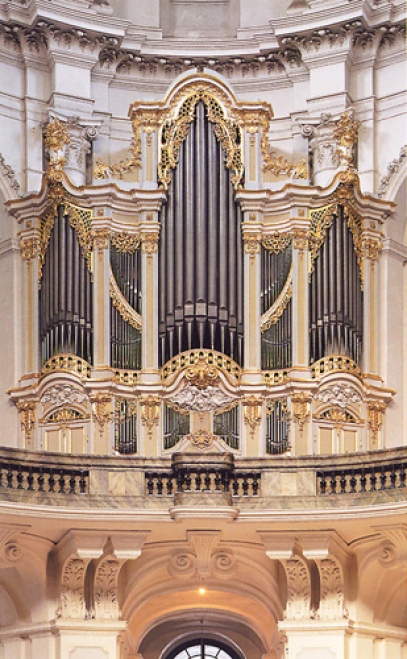


Dresden, cathedral/former court church

Gottfried Silbermann (+ 4.8.1753) and Zacharias Hildebrandt 1750-1755
State of preservation: Pipes (except the Unda maris stop) original.
Since 1836 in the care of the Jehmlich workshop; initially it probably had a pitch of c.413 Hz
(chamber pitch a1), a pitch conference in 1862 recorded a pitch of 425 Hz which was again heightened in 1884 and again in 1937 to 440 Hz. The pipes were put in storage in early 1944; the court church was heavily damaged at the Dresden air raid in 13th Feb.1945 and burnt, destroying the organ case and wind chests. Restored by Jehmlich with reconstruction of case and carvings in 1963-71, 2001/2 overhaul and restoration of pitch to now 415
Hz (equal temperament).
This is the biggest and last organ built by Gottfried Silbermann, and finished by his journeyman and workshop leader Zacharias Hildebrandt. The catholic Court church amidst the protestant heartland is a visible witness of the conversion of Augustus the Strong required to become elected king of Poland.
The case only shows two of the four divisions of the organ, Brustwerk below and Hauptwerk above the cornice. while the Oberwerk is placed behind the central tower and the Pedal in the rear. The specification invites comparison with Silbermann's first big contract, the organ of Freiberg cathedral: there only minor differences (eg Dresden HW: + Prinzipal 16’, + Spitzflöte 4’; 16’ and 8’ reeds instead of 8’ and 4’; solo reeds divided between OW and BW instead of both OW like in Freiberg) rather revealing adaption to acoustics of spaces and limitations within the cases than differing sound ideas. Both organs thus represent a common „Silbermann-Plan“ for organs of this size, modified within close limits according to local requirements. The French influence (typical reed stops) as well as certain sound ideas from southern Germany and Bohemia (Viola da gamba, Unda maris) are obvious as well.
Specification
III+P/47
HW:
Prinzipal 16’
Bordun 16’
Prinzipal 8’
Viola di Gamba 8’
Rohrflöte 8’
Kornett [8’] 5f.
Oktave 4’
Spitzflöte 4’
Quinta 3’
Oktave 2’
Tertia [13/5’]
Mixtur 4f.
Zimbeln 3f.
Fagott 16’
Trompete 8’
Tremulant
OW:
Quintaden 16’
Prinzipal 8’
Gedackt 8’
Quintaden 8’
Unda maris 8’ (new)
Echokornett [8’] 5f.
Oktave 4’
Rohrflöte 4’
Nassat 3’
Oktave 2’
Tertia [13/5’]
Flaschflöt 1’
Mixtur 4f.
Vox humana 8’
Schwebung
BW:
Gedackt 8’
Prinzipal 4’
Rohrflöte 4’
Nassat 3’
Sesquialtera [22/3’+13/5’]
Oktave 2’
Quinta 11/2’
Sufflöt 1’
Chalumeaux 8’
P:
Untersatz 32’
Prinzipalbaß 16’
Oktavbaß 8’
Oktavbaß 4’
Pedalmixtur 6f.
Posaunenbaß 16’
Trompetenbaß 8’
Clarinbaß 4’
Couplers: BW/HW, OW/HW, HW/P
Stoppeds, Nassats and chimney flutes made of metal (70 % tin/30 % lead), the others of English tin
Q: http://www.silbermann-orgeln.de/werke/ (and original research)
© Greifenberger Institut für Musikinstrumentenkunde | info@greifenberger-institut.de



